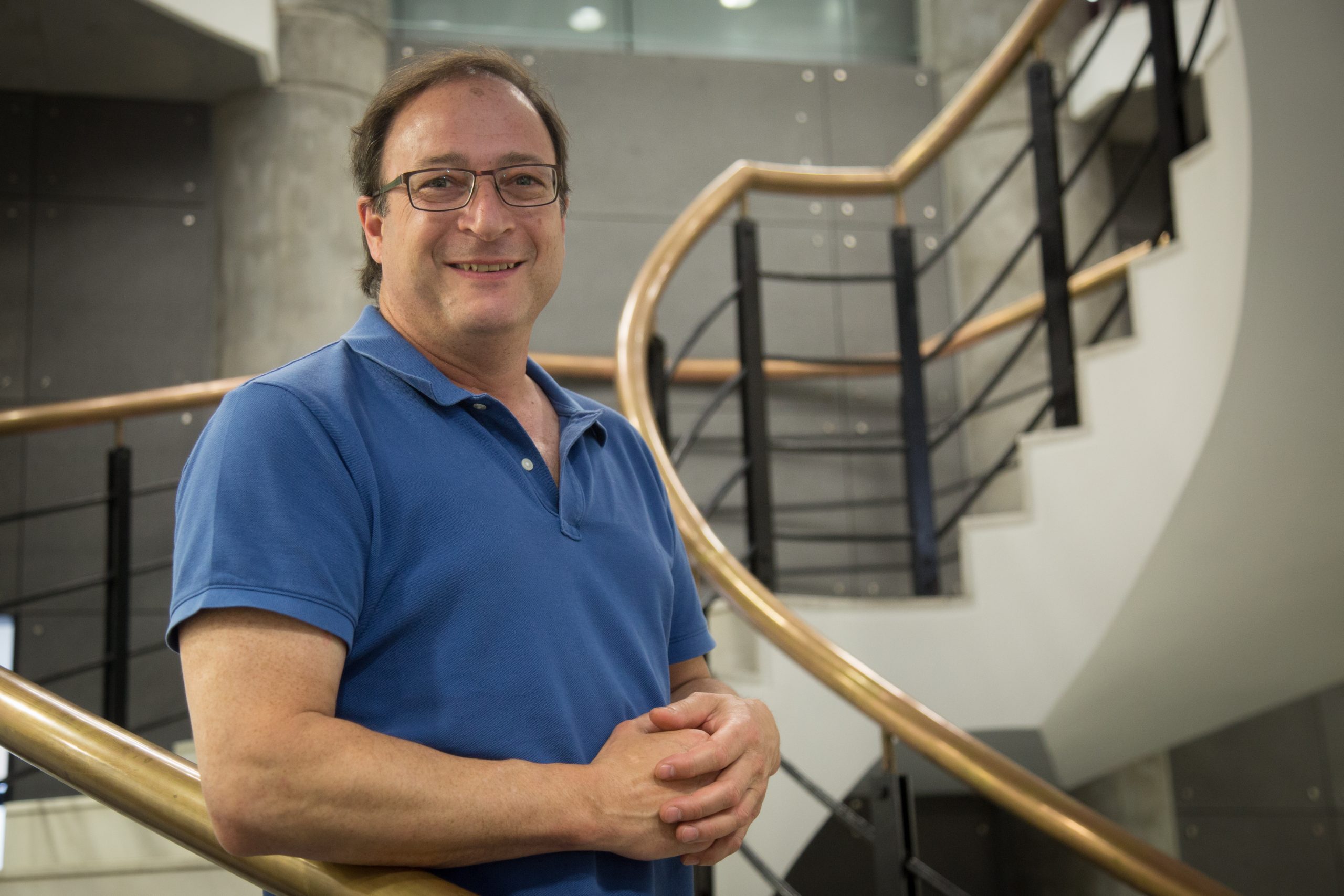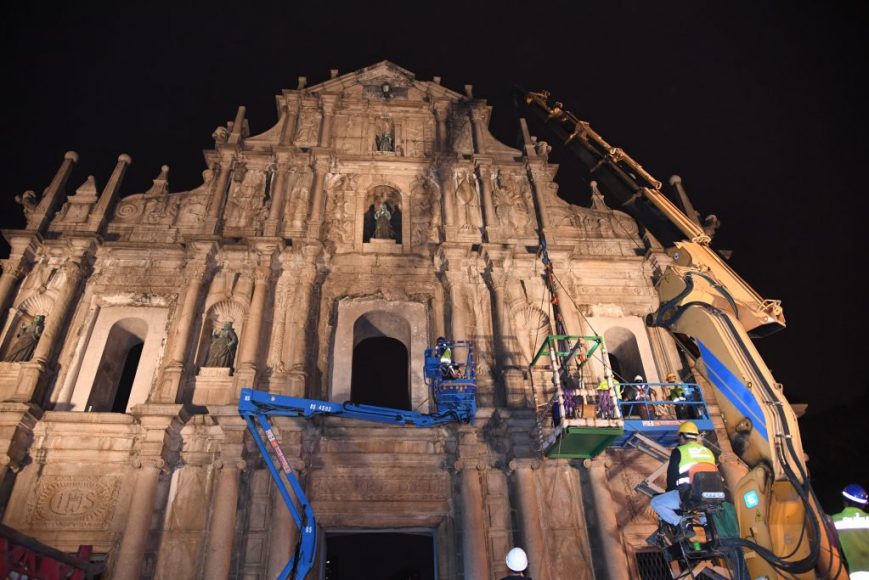In November 2017, Macao began restoration of the seven bronze statues that grace the facade of its most famous landmark: the Ruins of St. Paul’s, the last vestiges of a 17th‐ ‐century church.
On either side of three arched windows stand St. Aloysius Gonzaga, St. Francis Xavier, St. Ignatius of Loyola, and St. Francis Borgia. The Virgin Mary stands above the central window, with the Christ Child above her, and the Holy Spirit in the form of a dove, above him. The statues, each tucked into the decorative facade, have withstood fires, typhoons, human curiosity, and the city’s humid climate since they were placed at the front of the church in 1640.
The identity of the statues’ sculptor is unknown, although Asian artists trained by the Jesuits are believed to have worked on the decoration of the church. A famous cannon foundry existed in Macao, started by Manuel Tavares Bocarro in 1625, may have cast the statues.

“The sculptor did a very good job, enabling the seven to remain intact for nearly 400 years,” said Ian Miles, senior metals conservator at Artlab Australia, who restored St. Aloysius Gonzaga and St. Francis Xavier last year. “We hope our conservation work will help to preserve them for another 400 years at least.”
“This is one of the finest projects I have ever worked on. I thought of the Portuguese and the Age of Discovery and all those who have walked up the steps of St. Paul’s,” Miles enthused. “I am very passionate about cultural heritage and want to care for cultural material.”
Finding the right match
The Cultural Affairs Bureau (IC) began looking for specialists to restore the statues back in 2015. They contacted Dr Donald Ellsmore, an eminent heritage architect and convenor for the Association for Preservation Technology International (APT) Australasia Chapter, who recommended several companies that specialise in this type of conservation.
As part of Macao’s World Heritage Site, the Ruins of St. Paul’s fall under the purview of the International Council on Monuments and Sites, a Paris‐ ‐based professional association on the conservation and protection of cultural heritage places around the world. Under their rules, restoration work of this nature requires a global tender.
After considering the bids, the IC chose Adelaide‐based Artlab Australia, one of a small number of
firms with the necessary experience in this particular field of restoration. It employs 26 experienced conservators with specialty skills in different types of cultural heritage objects.
Established in 1985, Artlab Australia is an organisation under Arts SA, which manages the South Australian government’s funding for the arts and cultural heritage. As the largest conservation centre in the Southern hemisphere, Artlab handles everything from conservation programmes of the state’s extensive collections to corporate clientele to private individuals all over the world.

Born in Britain, Miles studied building conservation before immigrating to Australia, where he completed further studies in conservation of cultural material. He specialises in sculptures, monuments, buildings, and large technology objects like vehicles or aircraft.
Miles has applied his wide range of expertise to various institutional collections, including those of Museum Victoria, the Australian War Memorial, the Australian National Maritime Museum, and the Science Museum in London. He has worked on objects including a replica of the Apollo spaceship that landed on the moon, one of the first planes to make a longdistance flight, automotive items, and many outdoor sculptures.
Planning and execution
Miles and a colleague first arrived in Macao in November 2016. “This is a World Heritage site and very significant,” Miles said of the Ruins of St. Paul’s. “These are the last remaining objects of a building that burnt down in 1835. I have huge respect for the artefacts I work with.”
Jesuits built the structure, originally known as Mater Dei (Mother of God), in the early 17th century. The church, made of wood and rammed earth with stone walls, featured a spectacular stone facade with carved decoration incorporated both Portuguese and Chinese imagery. Set on the hillside, the splendour of the church was meant to express the triumph of the Roman Catholic Church.
In 1835, a fire ravaged the grand structure, leaving only the granite facade, parts of the walls, 68 stone steps, and other archaeological remains. The seven statues suffered only minor damage, although some original elements are now missing, such as the angels and crescent moon surrounding the Virgin Mary.
Miles and his colleagues conducted lengthy historical research and careful testing before beginning work on the two statues. “They have survived 400 years,” he explained, “but you can damage them in an instant.”
Their research focused on collecting as much information as possible about the statues and their unknown sculptor: what materials did he use and how did he mix them together? Only then could Miles work out how to restore them.
The IC provided a team of eight to assist the specialists. They erected temporary scaffolding around the facade to allow for closer examination of the figures. Miles’ best lead on the statues’ creation was Manuel Tavares Bocarro, a sculptor and cannon maker who moved from Goa to Macao, where he set up a foundry to make cannons.

“The caster of the statues used a brass alloy of copper and zinc which included 13 per cent lead,” Miles explained. “This was a very unusual mixture. The lead has helped to preserve the objects, which are in very good condition. If he had used bronze, there would be green corrosion. Instead, we found greyish corrosion. There was more corrosion on the head, hands and feet, which were a little green.”
A letter from the Jesuits dated 1644 states that the heads, hands, and feet of the statues had been painted red while the vestments were gilded. That layer of gold on the vestments helped protect the statues from deterioration. The open backs did not; conservators found bird nests inside the statues. Bird droppings are highly acidic, leading to corrosion and staining.
Inspecting the rear of the statues, they found eyelets, likely used by the sculptor to lift the 400kg statues onto the facade. After confirming the strength of the eyelets, the conservators used them to tie the statues back to the facade after reinstallation.
Miles moved through the conservation process carefully, consulting with specialists in Canada and Australia to confirm his approach as the best possible option before continuing. “This work is a balance between science, technology, art history, and manual dexterity.”
The best course of action, he decided, would be to remove the dirt, bird droppings, and pollution from the statues, then add a protective layer of wax coating to prevent water and oxygen from corroding the metal. Because of the high lead content, they had to use a hot air gun (similar to a hair dryer) to allow for a more controlled way of heating, as it is critical not to overheat the lead. Miles also decided to add netting to prevent birds from making nests within the statues.
The heads, hands, and feet of the statues had beenpainted red whilethe vestments were gilded. That layer of gold on the vestments helped protect the statues from deterioration.
The big day came to reinstall the two statues on 15 November last year – or rather, the big night. The IC elected to perform the operation in the middle of the night when there were no visitors, neatly avoiding any risk to passers‐by. A special purpose-built cage was used to safely lift the sculptures.
“We planned the lifting carefully,” Miles said, noting the plan went off without a hitch. Once the two pieces were removed from the facade, the team did the necessary repairs, taking for each statue a week to complete the work.
Then they put them back up, this time fastening them to the walls, a step the original sculptor did not take. The protective wax coating left the two statues slightly darker than they were before the work – a difference minor enough it may not be evident to visitors.

Two down, five to go
“There were challenges at every stage of the project. One was to get materials from Australia to Macao. Another was to write the treatment proposal, for a very strange metallurgy. Such a composition is not used in modern casting. It is unique and highly significant,” Miles explained, noting that the other statues could have a different metal composition.
As to the remaining five statues, the IC has not yet made its decision. There is at least one conservator eager to take the job: “I would love to do the other five and would love to have long‐ ‐term involvement,” Miles said. As part of his work on the two saints, he prepared a detailed report for the IC, which includes recommendations for the whole monument.
Beyond the technical challenge and cultural resonance of the job, Miles had high praise for the local eight‐person team who assisted him and his colleagues during the project. “We could not have done the work without them. They did a fantastic job. We have trained the team – Macao can do the maintenance.”
The statues of St. Aloysius Gonzaga and St. Francis Xavier, painstakingly restored by Miles and his team, will be admired by millions for many years to come. Their work helps ensure that future generations will retain this visceral connection to Macao’s storied past, a remnant of the Portuguese Jesuit influence that continues to shape the city today.



